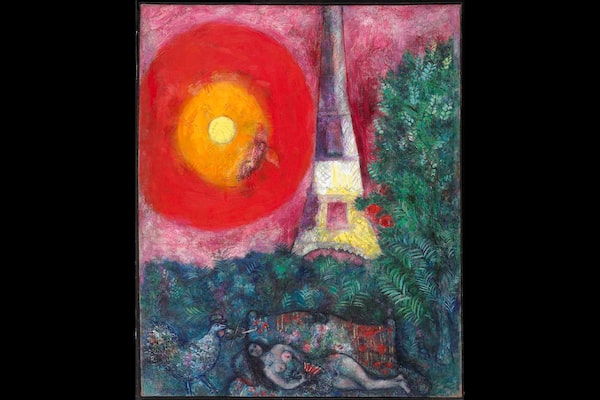The art world is abuzz over what piece of art the National Gallery of Canada wants to buy so badly that it is willing to part with a multi-million-dollar Marc Chagall painting to get it.
The gallery is selling the 1926 painting La Tour Eiffel by the Russian-French master at a Christie’s auction in New York next month for an estimated US$6-million to $9-million. The work will be sold at the prestigious auction house around the same time as a major collection of art from the estate of billionaires Peggy and David Rockefeller.

The Marc Chagall painting, The Eiffel Tower (1929), is an oil on canvas that is being sold by the National Gallery of Canada.National Gallery of Canada
The gallery said last week it had to sell the Chagall – just one of two paintings by the artist in its collection – to raise the funds to buy a more significant piece of art that was in imminent danger of leaving Canada.
“I can’t tell you anything. At the request of the owner, they don’t want us to divulge their identity or to identify the work,” Marc Mayer, director of the National Gallery, told The Globe and Mail. “There aren’t a lot of works of this value kicking around, so any little hint will identify it pretty much immediately.”
The gallery also said it’s paying fair market value for the mystery work, and the sale of the Chagall should generate all the money it needs.
On Wednesday, the latest candidate was the 18th-century French painting Saint Jérôme entendant les trompettes du jugement dernier by Jacques-Louis David. Notre-Dame de Quebec’s priest Denis Bélanger was quoted by the QMI news agency as saying the National Gallery had expressed interest in the piece, but there was no formal agreement. Mr. Bélanger said the church was making the sale in order to fund its activities and that it had approached other public institutions, too.
Even if the National Gallery is pursuing the David piece, it is not clear that it is selling the Chagall painting to obtain it. The gallery would not say, and the church did not respond to requests for comment.
The painting is currently being exhibited at the Montreal Museum of Fine Arts. The Musée de la civilisation in Quebec City, which has been the custodian of the painting since 1995, says it and the Montreal gallery have applied to the Quebec government to have the piece classified as cultural property because they think it’s an important part of the province’s heritage. A spokesperson for the museum said they are working with public and private sponsors to raise the funds for an outright purchase.
“This masterpiece has no equal in Quebec,” a spokesperson for the Montreal museum said.
Art dealers and auction houses tell The Globe they are sworn to secrecy about what sits in their own clients’ private collections, but they did offer some theories about what the mystery piece could be.
Most said it was unlikely to be a work from a Canadian because the price tag is too high.
“There are very few Canadian artists who command that kind of price level,” said Sharon London Liss, a Toronto fine-art dealer and president of the Art Dealers Association of Canada.
The record for Canadian art was set in 2016 with the $11.2-million sale of Mountain Forms, a renowned 1926 piece by Group of Seven painter Lawren Harris. Vent du nord, a 1953 work by Quebec artist Jean-Paul Riopelle, sold at Canadian auction house Heffel for $7.4-million last year. (Both prices include buyer’s premiums.)
“My guess is that they’re pretty rich in Riopelles, they probably don’t need another unless its something of the most extraordinary significance,” Ms. London Liss said.
One possible contender could be Cut Out Figure (1948) by American expressionist Jackson Pollock, a work owned by a private collector that has been loaned to the gallery for exhibitions.
Alan Klinkhoff, a Montreal art dealer, said the piece would be a natural long-term fit for the gallery’s collections.
“It can have teaching significance, with respect to someone like Riopelle, who is a significant Canadian figure of his generation. The Pollock canvas could contextualize Riopelle’s work,” Mr. Klinkhoff said.
He discounted the idea of the target being a big Canadian work, because, he said, none of those appears to be in danger of leaving the country.
Another piece being talked about is the Sanders portrait, a famous painting of William Shakespeare that is said to be one of the only likenesses of the Bard created in his lifetime. It has been in Canada for decades.
“I can definitively confirm that is not the case,” said Daniel Fischlin, a professor at the University of Guelph who has worked with the portrait for years. “The National Gallery was approached a few years ago, and we were rebuffed. The policy I was told was used to make the decision is that they do not acquire portraits or work based on the identity of the sitter.”
There is one artist, still alive, who has both international and Canadian experience and whose name is being talked about: Peter Doig. The artist, who was born in Britain, grew up in Canada, and lives in Trinidad, has had paintings fetch more than $10-million at auction in recent years.
“He’s the only artist with a Canadian connection that’s strong enough at that price level,” said Miriam Shiell, a veteran fine-art dealer in Toronto.
But Ms. Shiell said she was sorry to see the National Gallery part with a Chagall, no matter what the other painting on offer might be.
“To dip into the vault because you have a favourite child that you want more, there’s something not quite right about that,” she said.
With a report from Robert Everett-Green
 Chris Hannay
Chris Hannay